TOYOTA TUNDRA 2019 Owners Manual (in English)
Manufacturer: TOYOTA, Model Year: 2019, Model line: TUNDRA, Model: TOYOTA TUNDRA 2019Pages: 672, PDF Size: 14.1 MB
Page 201 of 672
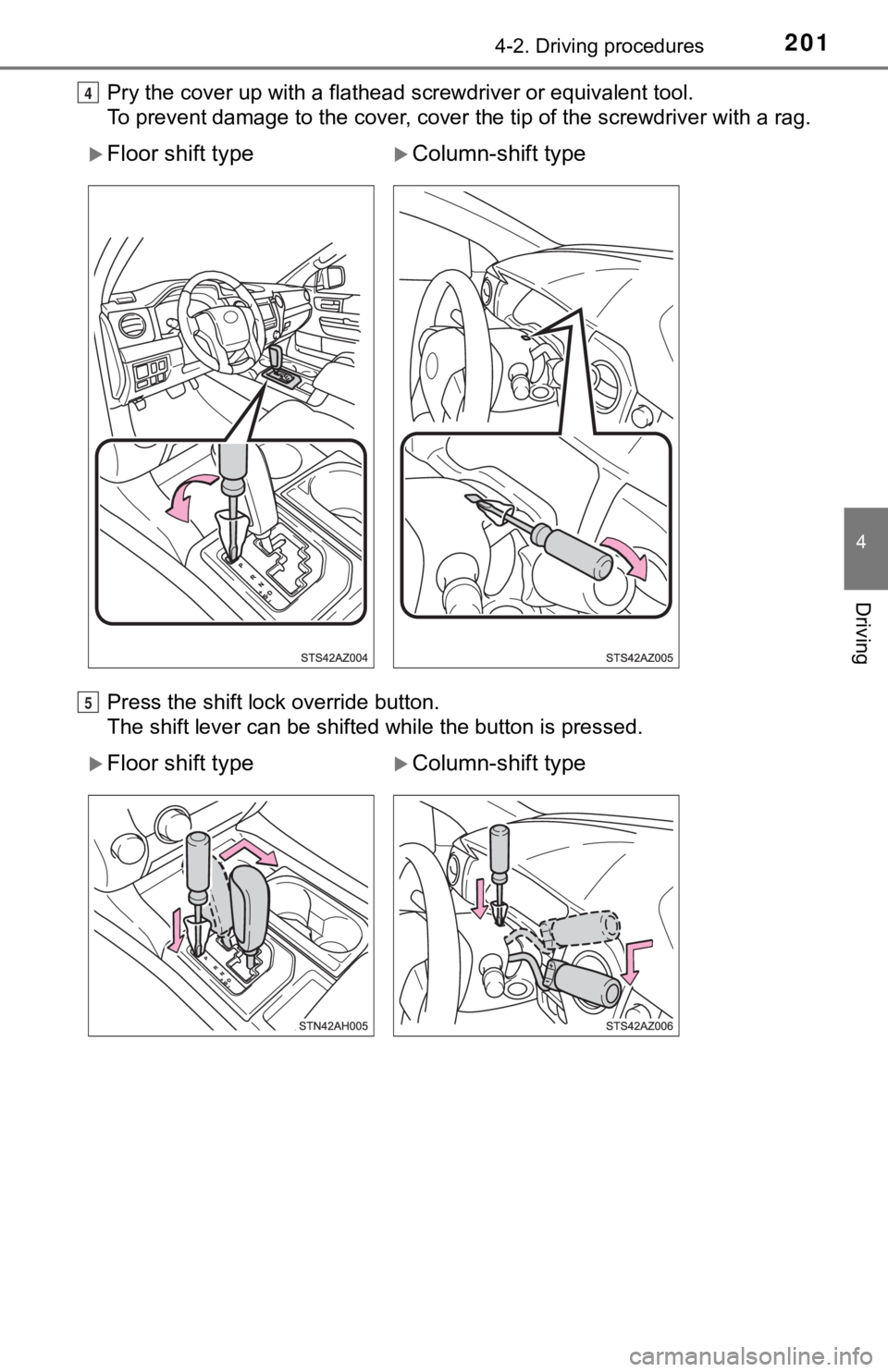
2014-2. Driving procedures
4
Driving
Pry the cover up with a flathead screwdriver or equivalent tool.
To prevent damage to the cover, cover the tip of the screwdrive r with a rag.
Press the shift lock override button.
The shift lever can be shifted while the button is pressed.4
Floor shift typeColumn-shift type
5
Floor shift typeColumn-shift type
Page 202 of 672

2024-2. Driving procedures
■If the “S” indicator does not come on even after shifting the s hift lever to
S
This may indicate a malfunction in the automatic transmission s ystem. Have
the vehicle inspected by your Toyota dealer, immediately.
(In this situation, the transmission will operate in the same m anner as when
the shift lever is in D.)
■ Downshifting restrictions warning buzzer (S mode)
To help ensure safety and driving performance, downshifting ope ration may
sometimes be restricted. In some circumstances, downshifting ma y not be
possible even when the shift lever is operated. (A buzzer will sound twice.)
■ Transmission protection function
If the tires spin continually when the vehicle becomes stuck in mud, dirt or
snow, the automatic transmission temperature may become too high and
cause damage.
To avoid the damaging the automatic transmission, the system may tempo-
rarily lock the gear in 1st.
If the automatic transmission temperature falls, the gear locki ng is canceled
and returns the automatic transmission to the normal operation.
WARNING
■ When driving on slippery road surfaces
Do not accelerate or shift gears suddenly.
Sudden changes in engine braking may cause the vehicle to spin or skid,
resulting in an accident.
■ To prevent an accident when releasing the shift lock
Before pressing the shift lock override button, make sure to se t the parking
brake and depress the brake pedal.
If the accelerator pedal is accidentally depressed instead of t he brake pedal
when the shift lock override button is pressed and the shift le ver is shifted
out of P, the vehicle may suddenly start, possibly leading to a n accident
resulting in death or serious injury.
Page 203 of 672
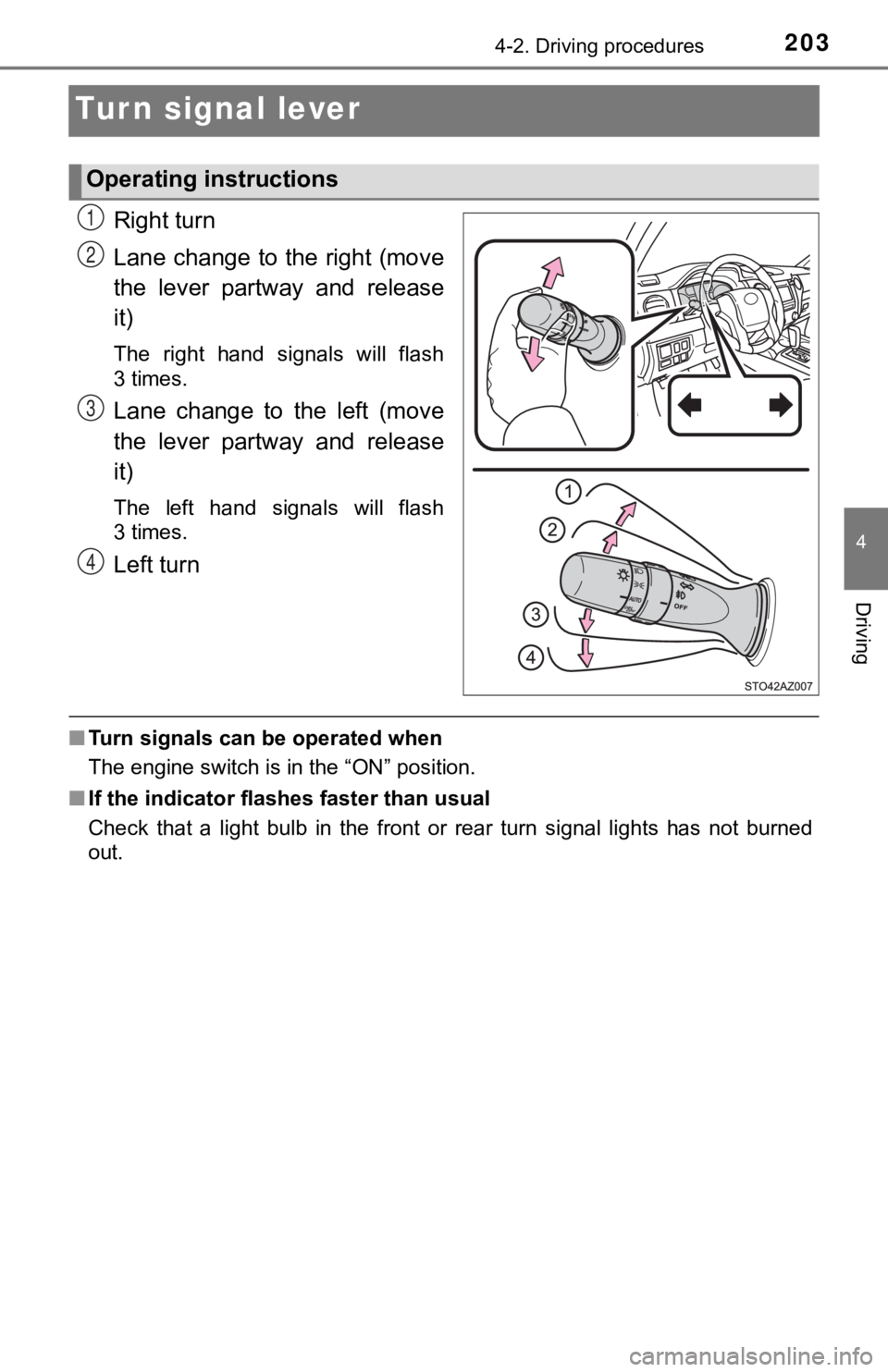
2034-2. Driving procedures
4
Driving
Turn signal lever
Right turn
Lane change to the right (move
the lever partway and release
it)
The right hand signals will flash
3times.
Lane change to the left (move
the lever partway and release
it)
The left hand signals will flash
3times.
Left turn
■Turn signals can be operated when
The engine switch is in the “ON” position.
■ If the indicator flashes faster than usual
Check that a light bulb in the front or rear turn signal lights has not burned
out.
Operating instructions
1
2
3
4
Page 204 of 672
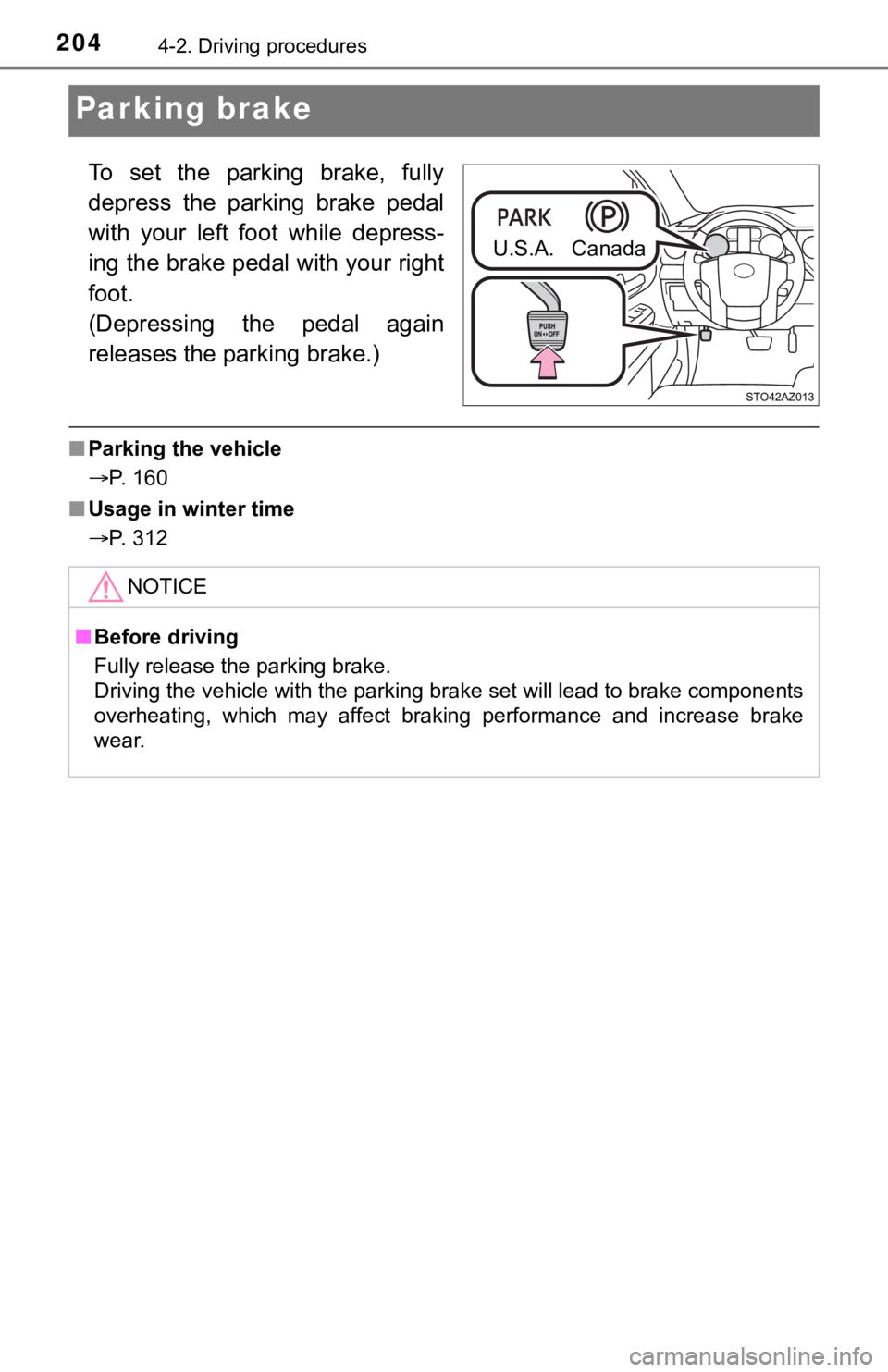
2044-2. Driving procedures
Parking brake
To set the parking brake, fully
depress the parking brake pedal
with your left foot while depress-
ing the brake pedal with your right
foot.
(Depressing the pedal again
releases the parking brake.)
■Parking the vehicle
P. 160
■ Usage in winter time
P. 312
U.S.A. Canada
NOTICE
■
Before driving
Fully release the parking brake.
Driving the vehicle with the parking brake set will lead to bra ke components
overheating, which may affect braking performance and increase brake
wear.
Page 205 of 672
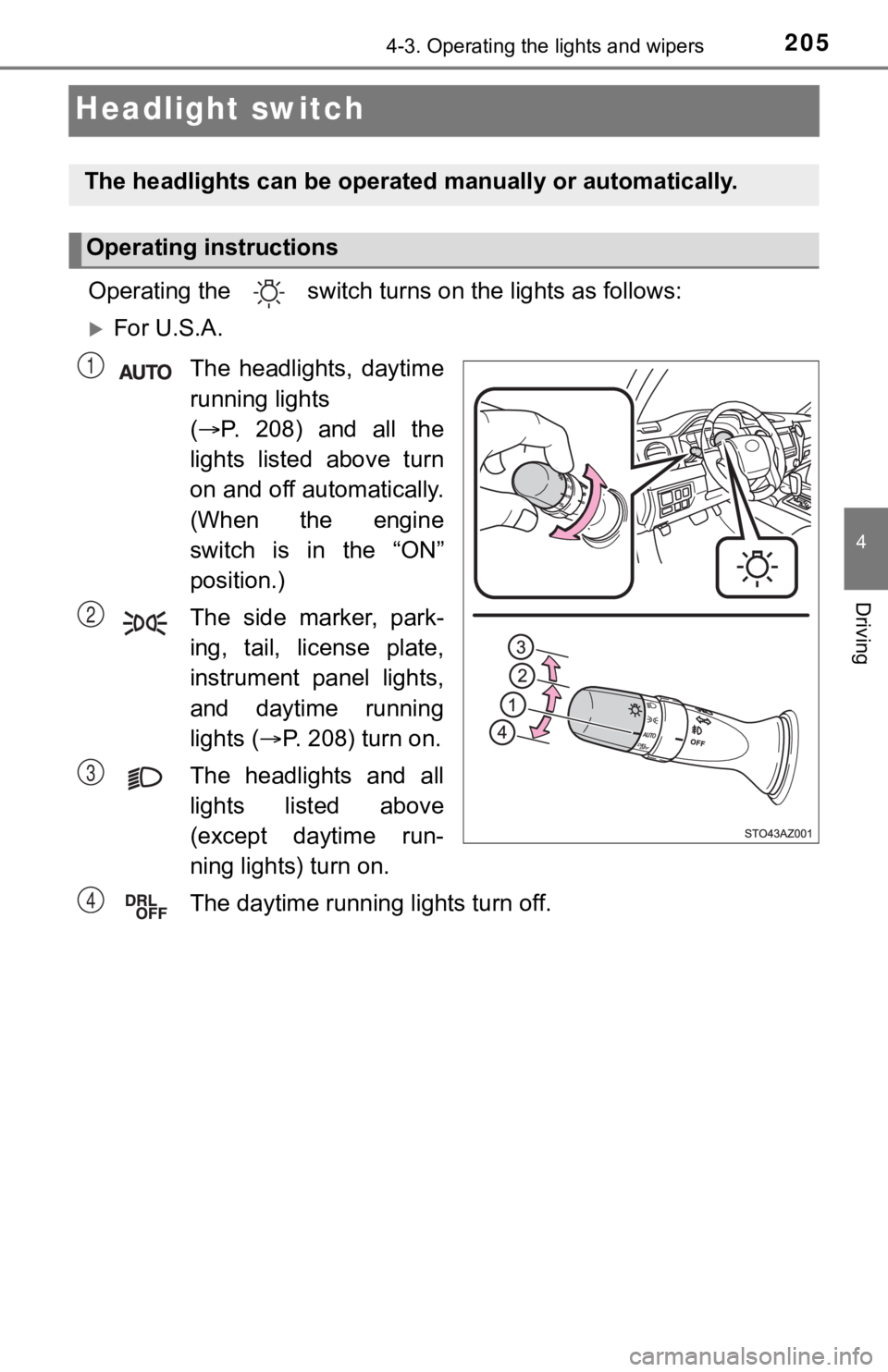
2054-3. Operating the lights and wipers
4
Driving
Headlight switch
Operating the switch turn s on the lights as follows:
For U.S.A.
The headlights, daytime
running lights
( P. 208) and all the
lights listed above turn
on and off automatically.
(When the engine
switch is in the “ON”
position.)
The side marker, park-
ing, tail, license plate,
instrument panel lights,
and daytime running
lights ( P. 208) turn on.
The headlights and all
lights listed above
(except daytime run-
ning lights) turn on.
The daytime running lights turn off.
The headlights can be operated manually or automatically.
Operating instructions
1
2
3
4
Page 206 of 672
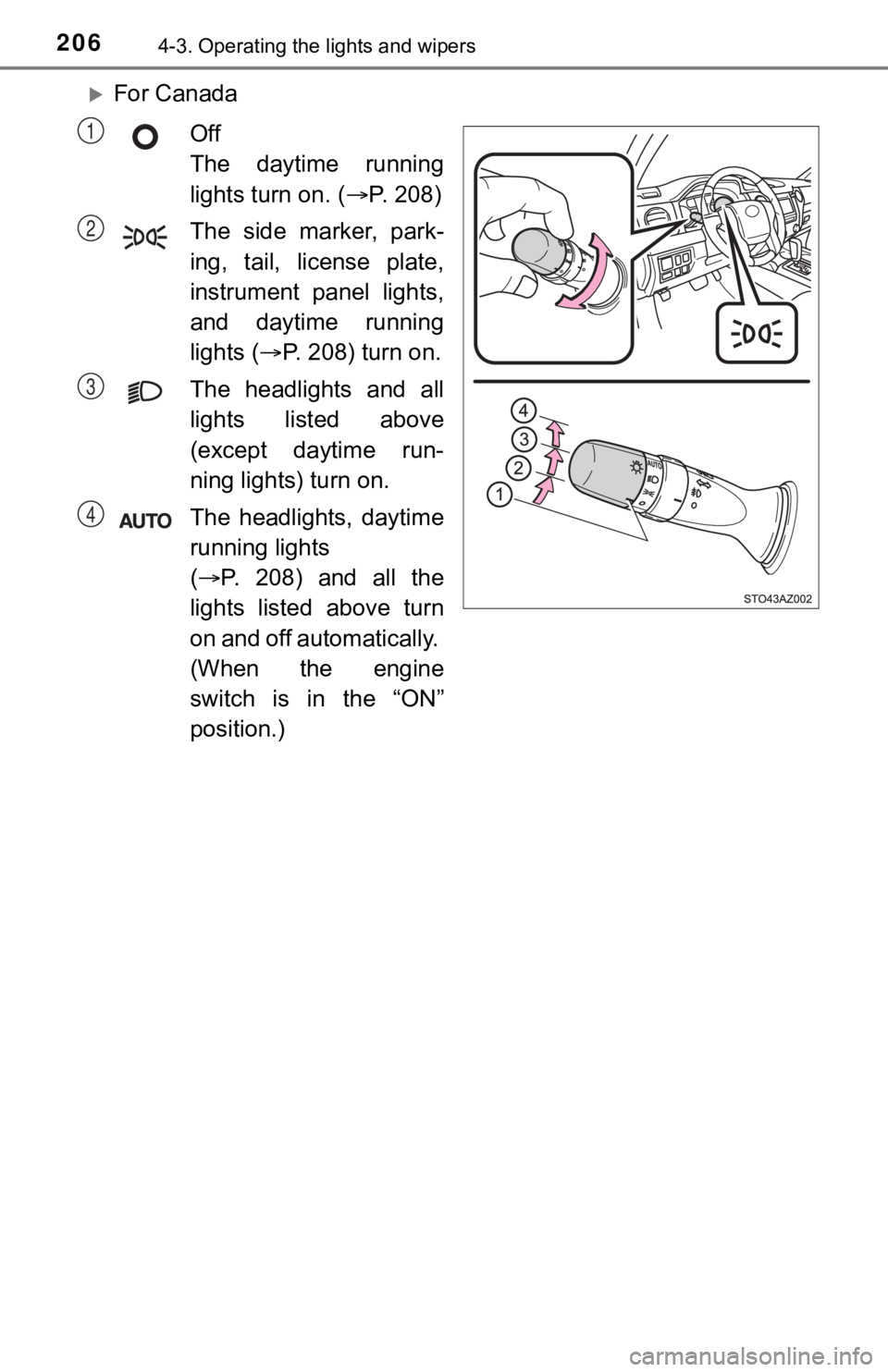
2064-3. Operating the lights and wipers
For CanadaOff
The daytime running
lights turn on. ( P. 208)
The side marker, park-
ing, tail, license plate,
instrument panel lights,
and daytime running
lights ( P. 208) turn on.
The headlights and all
lights listed above
(except daytime run-
ning lights) turn on.
The headlights, daytime
running lights
( P. 208) and all the
lights listed above turn
on and off automatically.
(When the engine
switch is in the “ON”
position.)
1
2
3
4
Page 207 of 672
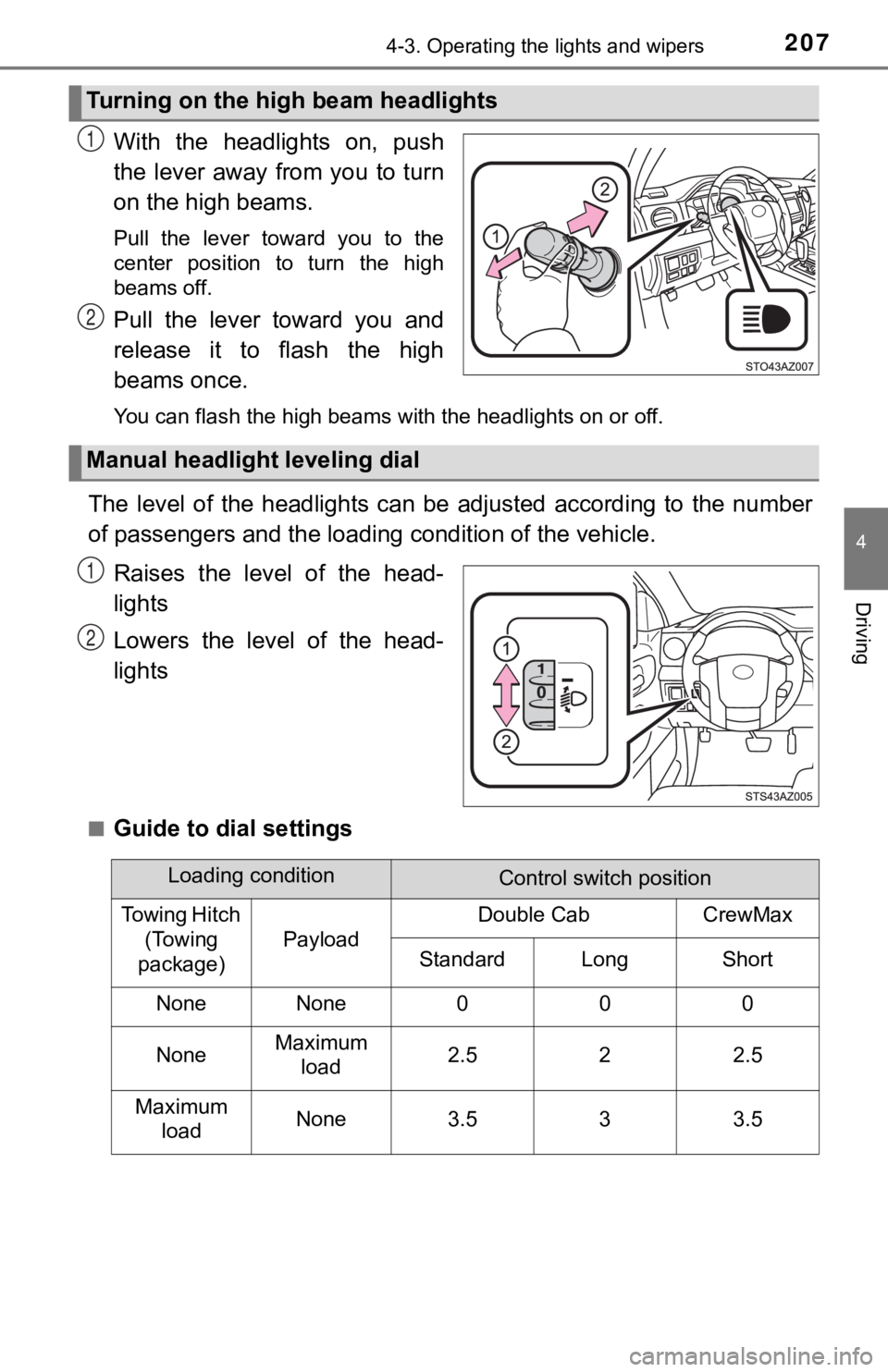
2074-3. Operating the lights and wipers
4
Driving
With the headlights on, push
the lever away from you to turn
on the high beams.
Pull the lever toward you to the
center position to turn the high
beams off.
Pull the lever toward you and
release it to flash the high
beams once.
You can flash the high beams with the headlights on or off.
The level of the headlights can be adjusted according to the nu mber
of passengers and the loadi ng condition of the vehicle.
Raises the level of the head-
lights
Lowers the level of the head-
lights
■Guide to dial settings
Turning on the high beam headlights
1
2
Manual headlight leveling dial
1
2
Loading conditionControl switch position
Towing Hitch (Towing
package)
Payload
Double CabCrewMax
StandardLongShort
NoneNone000
NoneMaximum load2.522.5
Maximum loadNone3.533.5
Page 208 of 672
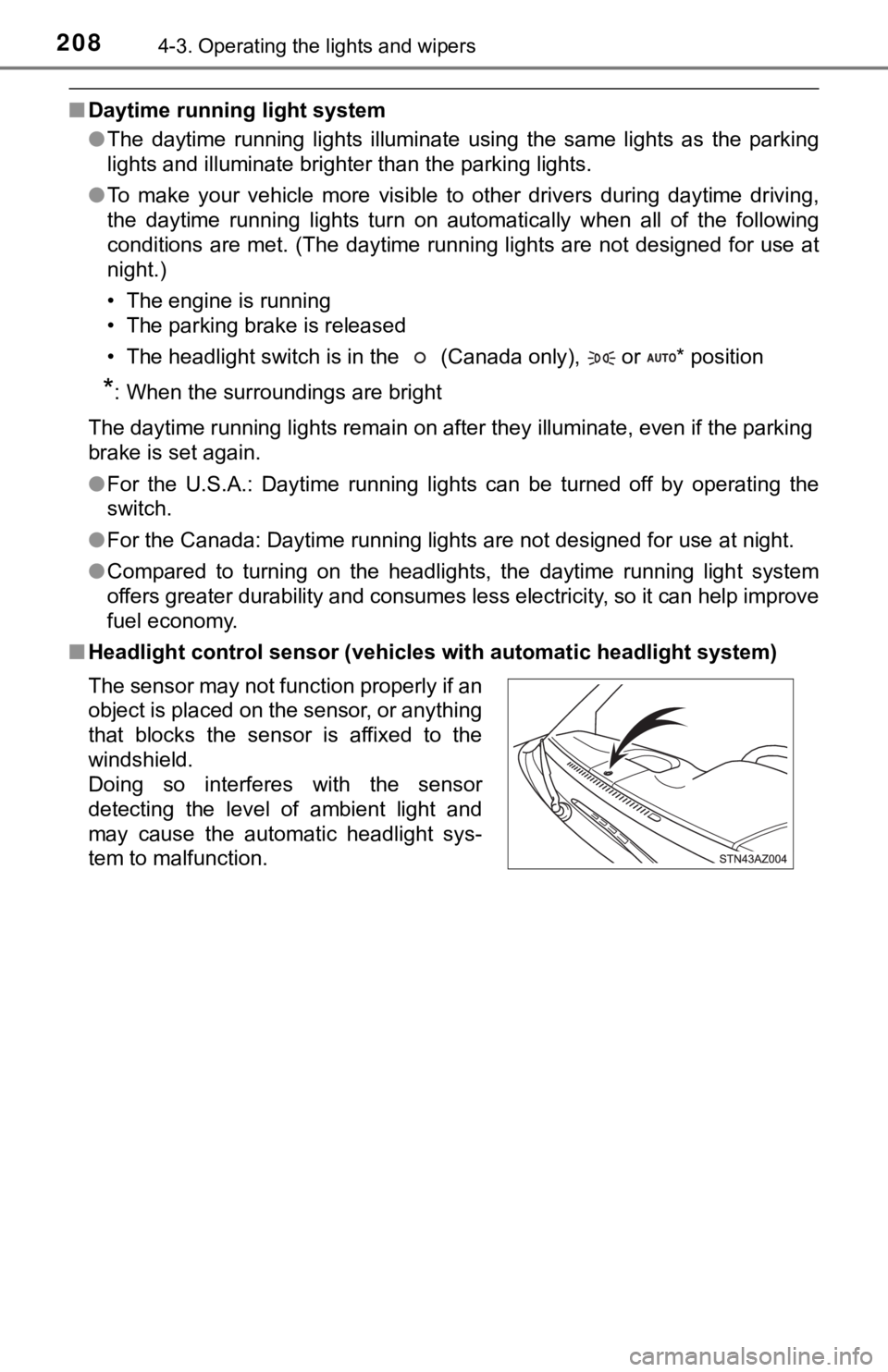
2084-3. Operating the lights and wipers
■Daytime running light system
●The daytime running lights illuminate using the same lights as the parking
lights and illuminate brighter than the parking lights.
● To make your vehicle more visible to other drivers during dayti me driving,
the daytime running lights turn on automatically when all of the following
conditions are met. (The daytime running lights are not designe d for use at
night.)
• The engine is running
• The parking brake is released
• The headlight switch is in the (Canada only), or * position
*: When the surroundings are bright
The daytime running lights remain on after they illuminate, even if the parking
brake is set again.
● For the U.S.A.: Daytime running lights can be turned off by ope rating the
switch.
● For the Canada: Daytime running lights are not designed for use at night.
● Compared to turning on the headlights, the daytime running ligh t system
offers greater durability and consumes less electricity, so it can help improve
fuel economy.
■ Headlight control sensor (vehicles with automatic headlight system)
The sensor may not function properly if an
object is placed on the sensor, or anything
that blocks the sensor is affixed to the
windshield.
Doing so interferes with the sensor
detecting the level of ambient light and
may cause the automatic headlight sys-
tem to malfunction.
Page 209 of 672
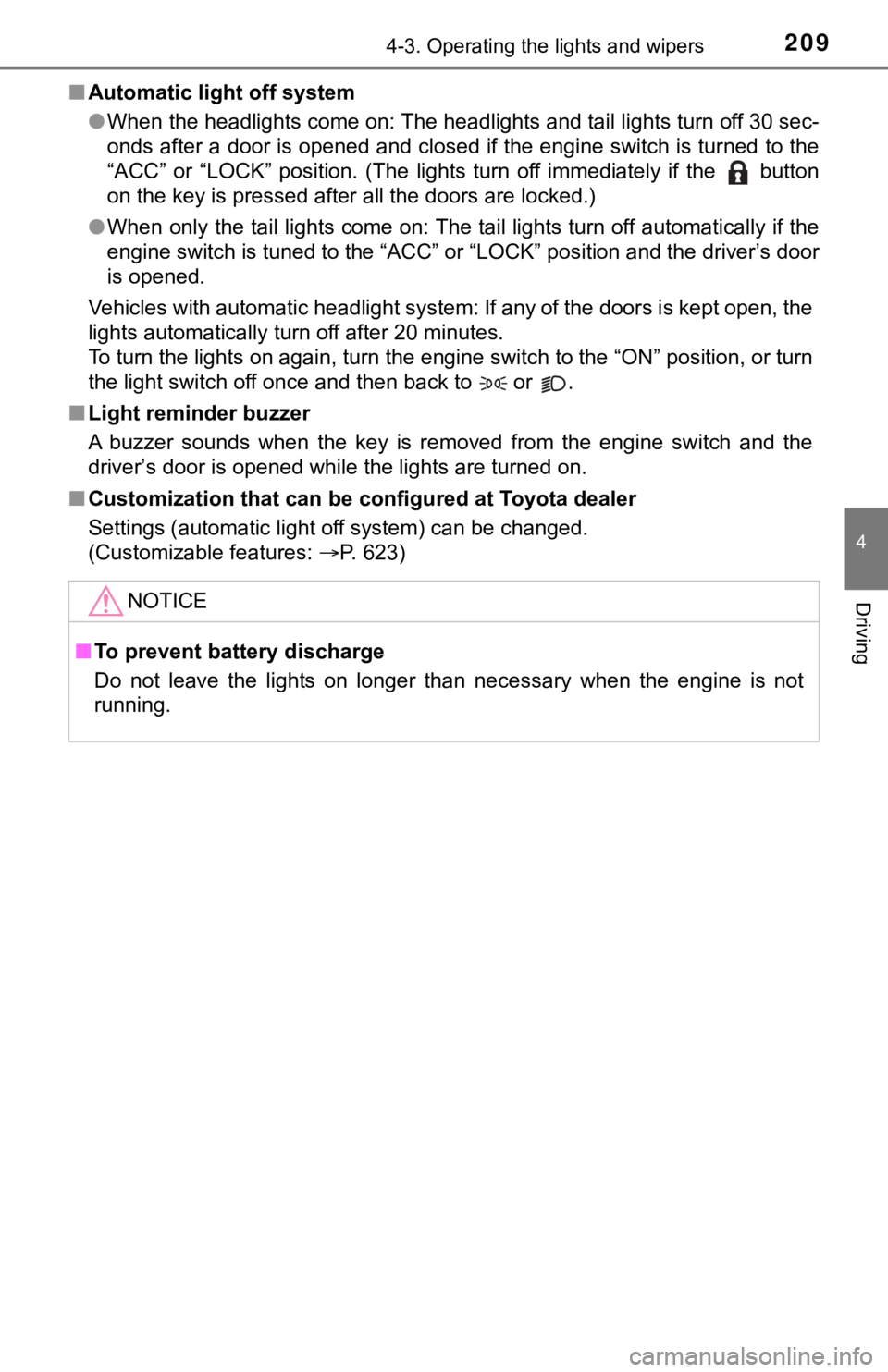
2094-3. Operating the lights and wipers
4
Driving
■Automatic light off system
●When the headlights come on: The headlights and tail lights tur n off 30 sec-
onds after a door is opened and closed if the engine switch is turned to the
“ACC” or “LOCK” position. (The lights turn off immediately if t he button
on the key is pressed after all the doors are locked.)
● When only the tail lights come on: The tail lights turn off aut omatically if the
engine switch is tuned to the “ACC” or “LOCK” position and the driver’s door
is opened.
Vehicles with automatic headlight system: If any of the doors i s kept open, the
lights automatically turn off after 20 minutes.
To turn the lights on again, turn the engine switch to the “ON” position, or turn
the light switch off once and then back to or .
■ Light reminder buzzer
A buzzer sounds when the key is removed from the engine switch and the
driver’s door is opened while the lights are turned on.
■ Customization that can be configured at Toyota dealer
Settings (automatic light off system) can be changed.
(Customizable features: P. 623)
NOTICE
■To prevent battery discharge
Do not leave the lights on longer than necessary when the engin e is not
running.
Page 210 of 672
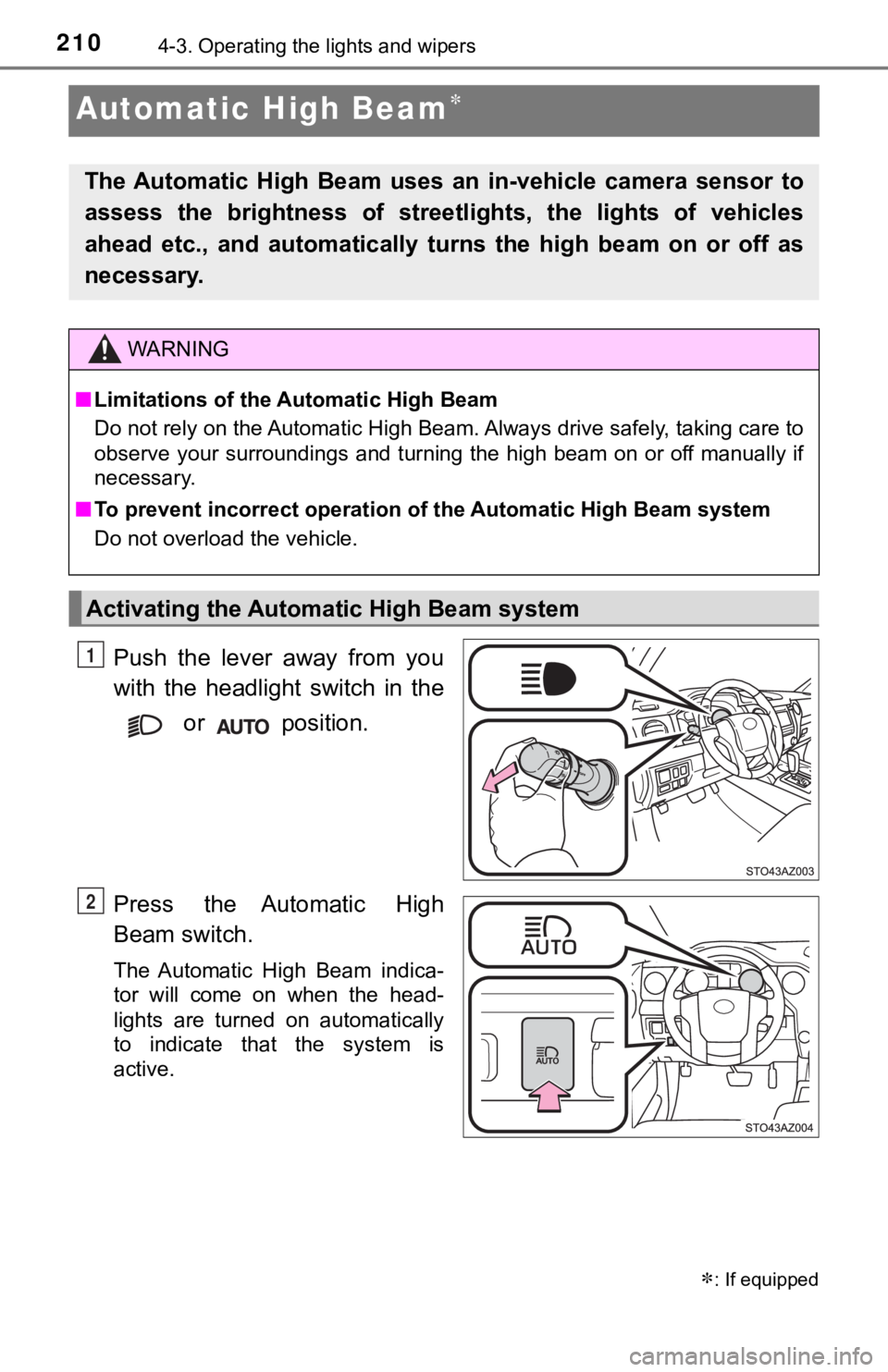
2104-3. Operating the lights and wipers
Automatic High Beam
Push the lever away from you
with the headlight switch in the or position.
Press the Automatic High
Beam switch.
The Automatic High Beam indica-
tor will come on when the head-
lights are turned on automatically
to indicate that the system is
active.
: If equipped
The Automatic High Beam uses an in-vehicle camera sensor to
assess the brightness of streetl ights, the lights of vehicles
ahead etc., and automatically turns the high beam on or off as
necessary.
WARNING
■ Limitations of the Automatic High Beam
Do not rely on the Automatic High Beam. Always drive safely, ta king care to
observe your surroundings and turning the high beam on or off m anually if
necessary.
■ To prevent incorrect operation o f the Automatic High Beam syste m
Do not overload the vehicle.
Activating the Automatic High Beam system
1
2